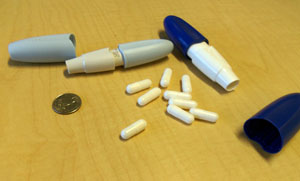Some day in the not-too-distant future, a dry powder inhaler once used to deliver insulin may help Parkinson’s patients overcome some of the most debilitating symptoms of the disease.
Back in 2008, in the wake of the Exhubera failure, Eli Lilly backed out of its partnership with Alkermes on the AIR inhaled insulin project. As a result, Alkermes shuttered a $40 million, 90,000 sq. ft. production facility in Chelsea, MA that it had just built to manufacture insulin.
That facility now serves as the headquarters for Civitas, whose lead candidate, CVT-301, is an inhaled L-dopa for the treatment of motor fluctuations, called “OFF episodes,” in Parkinson’s patients. The product, which has shown promising results in Phase 2 trials, is based on the same inhalation technology platform as AIR insulin.
The Michael J. Fox Foundation for Parkinson’s Research provided funding for a Phase 2B trial, which recently completed enrollment, and in the fall of 2013, the company announced that it had raised $38 million for development of CVT-301 through Phase 3.

The ARCUS dry powder inhaler
In January 2011, Civitas acquired all of the intellectual and physical property associated with the AIR platform when Alkermes spun out its respiratory business to the new company.
The AIR technology name came from its original developer, Advanced Inhalation Research, which was founded in 1997 by Robert Langer and David Edwards to commercialize large molecule inhalation powders developed at MIT and Penn State and which was acquired by Alkermes in 1999.
Thanks to the spin out, Civitas started off with an existing pipeline, GMP production facility, and technology platform. The company’s management also had extensive experience developing inhaled drugs, including co-founder and Chief Scientific Officer Rick Batycky who had helped to develop the AIR platform in the first place. What it lacked, says Batycky, was a name.
“When we started our series A, we had a different name. We had to change it at the request of investors, so we worked on that the day before closing the round,” he explains, and by the end, “It was kind of scrambling, like just pick one.”
The hasty selection may help explain the company’s unique pronunciation of its name. According to Batycky, “It was probably supposed to be pronounced “Siv’-ih-tahs,” but Sih-vee’-tas rolls a little easier off the tongue for us, so that’s how we say it.”
Civitas also renamed the inhalation platform, which is now known as “ARCUS.” The ARCUS platform includes both drug-only dry powder formulation technology and the breath-activated inhaler used to deliver large doses of drug.
ARCUS powders consist of porous particles with a very large geometric diameter in relation to their aerodynamic diameter. With few points of contact per volume, and therefore relatively low surface energy, the powder aerosolizes easily. CVT-301 has a geometric diameter of about 10 microns with an aerodynamic diameter of only about 3 microns, Batycky notes, and the ARCUS inhaler allows for delivery of tens of milligrams of the drug in a single inhalation.
“That’s important,” he says, “because L-dopa for the treatment of motor OFFs in Parkinson’s disease requires 20 -30 mg of drug delivered to the lung; we can do that in one or two inhalations.”


